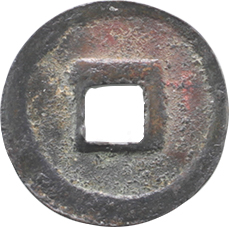
 (From left to right, top to bottom) This Jogan Eiho sold at auction for nearly $6250 after premium several years ago. These coins are also quite rare and less than one sells per year at AuctionWorld.
Photos sourced with permission from AuctionWorld
(From left to right, top to bottom) This Jogan Eiho sold at auction for nearly $6250 after premium several years ago. These coins are also quite rare and less than one sells per year at AuctionWorld.
Photos sourced with permission from AuctionWorld
Translating to “Everlasting Treasure of the Jogan era,” the Jogan Eiho (貞観永宝) is the ninth of the twelve antique coins of Japan. Released in January 870, this new coin remained in circulation for 20 years and spanned the reign of three Emperors. These were Emperor Seiwa until 876, Emperor Koko Tenno until 887 and Emperor Uda, who ruled until 897. Often recognized as the poorest of the twelve antique coins, the Jogan Eiho (also referred to as Jokwan Eiho) was created from copper mined primarily in the Bitchu and Bingu provinces. The low quality of these coins was most likely due to the lack of skill of the mint workers and terrible purity of the copper, which was less than 50% copper. To no surprise the Japanese public were quite reluctant to accept yet another currency, again at the rate of one new coins to ten of all old coins in circulation. Additionally, the coins were so crude that the government had to issue a decree that anyone who refused to accept the coins would be whipped in court. In addition to this, the Japanese court reprimanded the mints for the quality of the coins in 872. As with the other 12 antique coins, the obverse shows the four character inscription that is the name of the coin, and the reverse is blank. No major varieties exist, but there are several pertaining to the calligraphy. Despite its reputation, the ninth of the twelve antique, the Jogan Eiho, served the Japanese people for 20 years until 890.